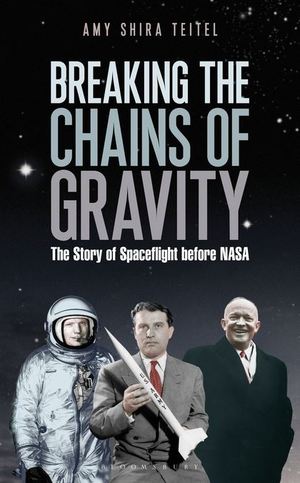
“Breaking the Chains of Gravity” (Bloomsbury, 2015), by Amy Shira Teitel, explores the little-known early history of spaceflight before NASA.
Credit: Bloomsbury
A new, pre-NASA history of rocketry and spaceflight delves into the lesser-known roots of that organization — the different paths that brought the founding fathers of rocketry together to work on putting the first satellites and humans into space.
“Breaking the Chains of Gravity” (Bloomsbury, 2015) takes for its focus the earliest rocket experiments and military projects that eventually formed the core of spaceflight research in America, and the many institutions with differing goals that came and went, working with and against one another on projects that eventually became humanity’s early excursions into space. Read an excerpt of the book here .
Space.com talked with “Breaking the Chains of Gravity ” author Amy Shira Teitel, who also runs the spaceflight history blog Vintage Space , to discuss the educated guesswork of rocketry, the best of little-known space history and the importance of telling early-spaceflight stories. [Top Milestones in Human Spaceflight ]
Space.com: Why did you choose to write about early space history?
Amy Shira Teitel: I’ve always been really fascinated with the first time things are done, and the first time you have to solve these complex problems, like going into space. My own interest in that, from my undergrad and grad-school days, was always there. And I realize that it hasn’t really been covered, necessarily, for a popular audience.
So many of the popular science books start with the Mercury astronauts [America’s first manned space program] or the hotshot fighter jocks and stuff because that’s the fun, exciting human element. This is actually a really fun part of the story that I think would make people appreciate and understand that “Right Stuff era” history a little bit more. I just kind of love it, and I really wanted to tell it in a way that anybody, no matter how little they knew about the history, would be able to access it and understand it and really appreciate it.
Space.com: What do you think is the most exciting part of spaceflight history that few people know about?
Teitel: All of them? One of the things that I was most excited to draw out in this book and that I’ve always been really interested in is just how much it was an unknown entity by the people that have since become associated with being the geniuses that brought rocketry to fruition. The stories of [Wernher] von Braun almost blowing himself up during a combustion chamber test. Von Braun and the Saturn V [rocket] go together — you don’t think about him as a young engineer almost killing himself because he didn’t understand the fine intricacies of what was going to happen when you introduced these two fuel oxidizers superchilled in a combustion chamber. The fact that there was so much failure and so much educated guesswork involved, I think is such an interesting part of the story, because you forget that this stuff is not known. It’s so known now. […] Nothing worked in the ’30s, but that was okay because they learned every step of the way.

Amy Shira Teitel is the author of “Breaking the Chains of Gravity.” She also runs the blog Vintage Space.
Credit: Bloomsbury
Space.com: Is there any aspect of space science that’s like that now?
Teitel: I’m sure on some level, pretty much everything is. I wonder when you look at the new technologies people are bringing up — I don’t know the details because SpaceX is not public, so you can’t get access to all their stuff, but landing the rocket stage upright I imagine is sort of equivalent in terms of, this is something that people had an idea of before but haven’t been able to execute it. […] You imagine that every failure brings to light some new problem that nobody had really thought of or that makes the technology that much closer to working.
I’ve always been amazed that the Sky Crane actually worked for the Curiosity rover [currently exploring Mars]. I can only imagine the number of weird failures that had to happen to iron out all the kinks in that system. I think the difference now is you have computer models that can do a lot of things for you, whereas in the ’30s and ’40s you just had to do it. I would hazard a guess that failures are more discreet now because you don’t have to do them publicly, you can do them privately in a computer. With things like Sky Crane and loading, not with landing on a barge — it’s a different thing, but I feel like that culture of trial and error — but leaning from error — very much still exists. [7 Minutes of Terror: Curiosity Rover’s Risky Mars Landing ]
Space.com: What challenges did you face in constraining the scope of what you covered?
Teitel:I would say the challenges were twofold. On the one hand, keeping it as a tight narrative, writing for a popular audience and knowing that my audience wouldn’t be super well-versed in this stuff. Try not to overwhelm them with too many details and with too many things coming simultaneously. I wanted to see a jumping-off point for people who wanted to dig into all the facets of things without giving them an encyclopedia’s worth of stuff to deal with. The decisions of keeping the narrative tight and constrained for the sake of a general readership. And the other half of that was, as soon as you don’t talk about somebody — one historical figure — you know there’s going to be a subset of space nerds who are going to be really upset with you.
Rather than force [everything] into this narrative and make it clunky or overwhelming, just keep the bits that needed to be there and hope that maybe somebody would be curious enough to ask questions about it later on.
Space.com: Why write about space history?
Teitel: It’s kind of a two-part thing. There’s something to be said for understanding the history and the roots of what’s happening in space now, and understanding how hard it is, how difficult, how varied the history is, to make you appreciate what’s happening now that much more.
It looks routine, but you’re still launching people on rockets into an incredibly hostile environment and hoping that they don’t die, in an orbiting can , for a year at a time. That’s insane, when you think about it. Understanding how quickly this has become something that is “routine,” I think is really interesting. But there’s also the fact that my generation risks not caring if somebody doesn’t help keep it alive in a way that is accessible and exciting for a younger audience. […] They just don’t seem interested that we did something that daring and that technologically sophisticated as go to the moon in the ’60s. So keeping it alive for my generation; I want to do my part to make sure that we don’t forget that this was a thing that humans did.
Email Sarah Lewin at slewin@space.com or follow her @SarahExplains . Follow us @Spacedotcom , Facebook and Google+ . Original article on Space.com .

Comments are closed.